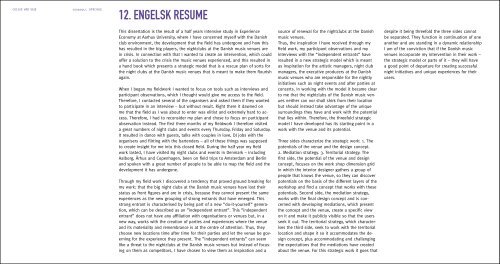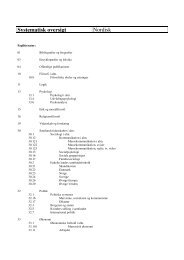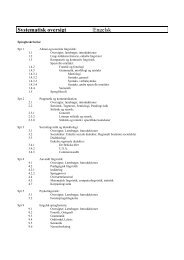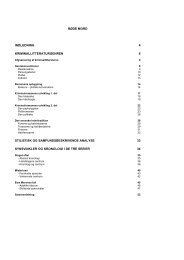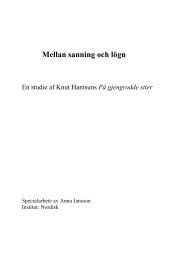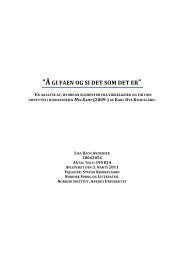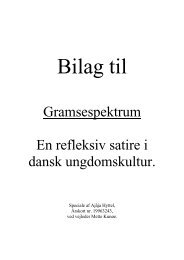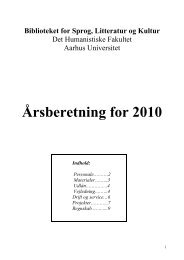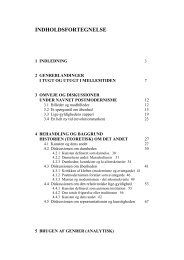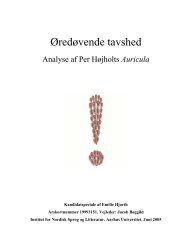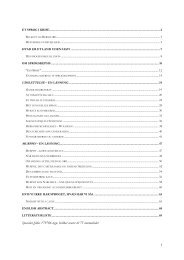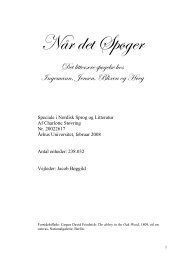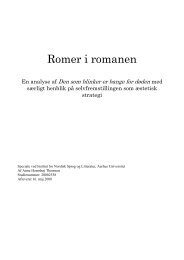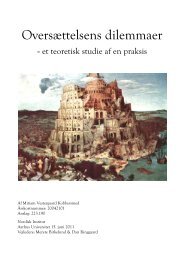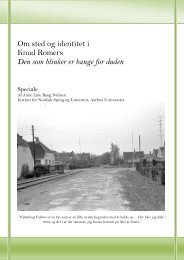OPLEVELSER PÅ STEDER OM NATTEN - UDVIKLING AF ...
OPLEVELSER PÅ STEDER OM NATTEN - UDVIKLING AF ...
OPLEVELSER PÅ STEDER OM NATTEN - UDVIKLING AF ...
You also want an ePaper? Increase the reach of your titles
YUMPU automatically turns print PDFs into web optimized ePapers that Google loves.
CECILIE VAD VEJE 20050917, SPECIALE<br />
12. ENGELSK RESUME<br />
This dissertation is the result of a half years intensive study in Experience<br />
Economy at Aarhus University, where I have concerned myself with the Danish<br />
club environment, the development that the field has undergone and how this<br />
has resulted in the big players, the nightclubs at the Danish music venues are<br />
in crisis. In connection with that I wanted to create an intervention, which could<br />
offer a solution to the crisis the music venues experienced, and this resulted in<br />
a hand book which presents a strategic model that is a rescue plan of sorts for<br />
the night clubs at the Danish music venues that is meant to make them flourish<br />
again.<br />
When I began my fieldwork I wanted to focus on tools such as interviews and<br />
participant observations, which I thought would give me access to the field.<br />
Therefore, I contacted several of the organisers and asked them if they wanted<br />
to participate in an interview – but without result. Right there it dawned on<br />
me that the field as I was about to enter was elitist and extremely hard to access.<br />
Therefore, I had to reconsider my plan and chose to focus on participant<br />
observation instead. The first three months of my fieldwork I therefore visited<br />
a great numbers of night clubs and events every Thursday, Friday and Saturday.<br />
It resulted in dance with guests, talks with couples in love, DJ jobs with the<br />
organisers and flirting with the bartenders – all of these things was supposed<br />
to create insight for me into this closed field. During the half year my field<br />
work lasted, I have visited 89 night clubs and events in Denmark – including<br />
Aalborg, Århus and Copenhagen, been on field trips to Amsterdam and Berlin<br />
and spoken with a great number of people to be able to map the field and the<br />
development it has undergone.<br />
Through my field work I discovered a tendency that proved ground breaking for<br />
my work: that the big night clubs at the Danish music venues have lost their<br />
status as front figures and are in crisis, because they cannot present the same<br />
experiences as the new grouping of strong entrants that have emerged. This<br />
strong entrant is characterised by being part of a new ”do-it-yourself” generation,<br />
which can be described as an ”independent entrant”. This ”independent<br />
entrant” does not have any affiliation with organisations or venues but, in a<br />
new way, works with the creation of parties and experiences where the venue<br />
and its materiality and remembrance is at the centre of attention. Thus, they<br />
choose new locations time after time for their parties and let the venue be governing<br />
for the experience they present. The ”independent entrants” can seem<br />
like a threat to the nightclubs at the Danish music venues but instead of focusing<br />
on them as competitors, I have chosen to view them as inspiration and a<br />
source of renewal for the nightclubs at the Danish<br />
music venues.<br />
Thus, the inspiration I have received through my<br />
field work, my participant observations and my<br />
interviews with the ”independent entrants” have<br />
resulted in a new strategic model which is meant<br />
as inspiration for the artistic managers, night club<br />
managers, the executive producers at the Danish<br />
music venues who are responsible for the nightly<br />
initiatives such as night events and after parties at<br />
concerts. In working with the model it became clear<br />
to me that the nightclubs of the Danish music venues<br />
neither can nor shall shirk from their location<br />
but should instead take advantage of the unique<br />
surroundings they have and work with the potential<br />
that lies within. Therefore, the threefold strategic<br />
model I have developed has its starting point in a<br />
work with the venue and its potential.<br />
Three sides characterize the strategic work: 1. The<br />
potentials of the venue and the design concept.<br />
2. Mediation strategy. 3. Territorial strategy. The<br />
first side, the potential of the venue and design<br />
concept, focuses on the work shop dimension grid<br />
in which the interior designer gathers a group of<br />
people that knows the venue, so they can discover<br />
potentials on the basis of the different layers of the<br />
workshop and find a concept that works with these<br />
potentials. Second side, the mediation strategy,<br />
works with the final design concept and is concerned<br />
with developing mediations, which present<br />
the concept and the venue, create a specific view<br />
on it and make it publicly visible so that the users<br />
seek it out. The territorial strategy, which characterises<br />
the third side, seek to work with the territorial<br />
location and shape it so it accommodates the design<br />
concept, plus accommodating and challenging<br />
the expectations that the mediations have created<br />
about the venue. For this strategic work it goes that<br />
despite it being threefold the three sides cannot<br />
be separated. They function in continuation of one<br />
another and are standing in a dynamic relationship<br />
I am of the conviction that if the Danish music<br />
venues incorporate my intervention in their work –<br />
the strategic model or parts of it – they will have<br />
a good point of departure for creating successful<br />
night initiatives and unique experiences for their<br />
users.<br />
13. LITTERATURLISTE<br />
Appadurai, A. (2005): Disjuncture and Difference in<br />
the Global Cultural Economy, I Modernity at Large –<br />
Cultural Dimensions of Globalization, Public worlds,<br />
Volume 1, Univerity of Minnesota Press, Minneapolis<br />
London<br />
Boswijk, A., Thijssen, T. & Peelen, E. (2007): Kap<br />
2+3 I The New Economy, A New Perspective. Amsterdam:<br />
Pearson Practice Hall (MANGELR DER NOGET<br />
HER)<br />
Böhme, G. (1993): Atmosphere as the Fundamental<br />
Concept of a New Aesthetics, Thesis Eleven (36),<br />
Massachuserrs Institute of Technology<br />
Crouch, D. (2000): Surrounded by place: Embodied<br />
Encounters, Routledge London and New York<br />
Couldry, N. (2005): On the actual street, I Crouch,<br />
David, Jackson, Rhonda & Thompson, Felix, The<br />
Media & Tourist Imagination, Routledge, Abingdon,<br />
Franck, K. og Quentin, S. (2007): Loose Space,<br />
Routledge, London, New York.<br />
Ingold, T. (2003): Three in one: How an ecological<br />
approach can obviate the distinctions between<br />
body, mind and culture, I Imagining Nature – Practices<br />
of Cosmology, Roepstorff, Andreas m.fl., Aarhus<br />
University Press<br />
Jannson, A. (2002): Spatial Phantasmogoria, The<br />
Mediatization of Tourism Wxperience, i European<br />
Journal of Communication, Vol 17 (4), London, Thousands<br />
Oaks and New Delhi<br />
Knudsen, B. (2009): Introduction – from representational<br />
to perceived authenticity in Contemporary<br />
culture and economy, i Re-investing Authenticy,<br />
Tourism, Place and Emotions, Leeds, Leeds Metropolitan University<br />
Knudsen, B. & Thomsen, BM. (2002): Indledning i Virkelighedshunger – nyrealisme<br />
i visuel optik, Tiderne Skifter, København<br />
Kristensen, J. (2009): Dimension grid workshop, Århus Universitet<br />
Lowenthal, D. (1985): The Past is a Foreign Country, University Press, Cambridge<br />
Massey, D. (1994): Space, Place and Gender Polity Press and Blackwell Publishers,<br />
Oxford<br />
Merleau-Ponty, M. (1994 [1945]): Kroppens fænomenologi, Det lille Forlag,<br />
Frederiksberg<br />
Otto, L. (2005): Introduktion til Forskningsfeltet, I Materialitet og dannelse – En<br />
studiebog, Danmarks Pædagogiske Universitets Forlag, København<br />
Otto, L. (2005): Materialitet, identitet og erindring, I Materialitet og dannelse –<br />
En studiebog, Danmarks Pædagogiske Universitets Forlag, København<br />
Robertson, R. (1995): Glocalization: Time – Space and homogeneity - Heterogeneity<br />
I Mike Featherstone, Scott Lash and Roland Robertson Global Modernities,<br />
London, Thousand Oaks & New Delhi<br />
Rojek, C. (2000): Indexing, Dragging and the Social Construction of Tourist<br />
Sights, I Rojek, Chris, Urry, John, Touring Cultures, Transformations of Travel and<br />
Theory, Routledge, London og Newyork<br />
Sandvik, K. (2009): Crime scenes as augmented reality, Models for enhancing<br />
places emotionally by means of narratives, fictions and virtual reality, I Re- investing<br />
Authenticity, Tourism, Place and Emotions, Leeds: Leeds Metropolitan<br />
University<br />
Sarasvathy, S. (2005): New Market Creation through Transformation. Journal of<br />
Evolutionary Economics. Vol. 15, No. 5<br />
Schjødt, J.P, (1992): Ritualstruktur og ritualklassifiktaion, I Religionsvidenskabligt<br />
tidskrift 20<br />
Schön, D. (1983): The reflecsive practioner, Temple<br />
Smith<br />
Scott, S. og Venkataraman, S (2000): The Promise<br />
of Entrepreneurship as a Field of Research. Academy<br />
of Management Review, Vol. 25, No. 1<br />
Soja, E., W. (1989): Postmodern Geographies – The<br />
Reassertion of Space in Critical Social Theory, Verso,<br />
London New York<br />
Thackara, J. (2005): In the Bubble- Designing in a<br />
Complex World, The MIT Press Cambridge, Massachusetts,<br />
London<br />
Tomlinson, J. (1999): Globalization and Culture Polity<br />
Press, Cambridge<br />
Turner, V. (1977):Variations on a Theme of liminality,<br />
I Moore & Meyerhoff, Secular Ritual, Van Gorcum<br />
Urry, J. (2001): The Tourist Gaze, I The Tourist Gaze,<br />
London, Thousands Oaks, New Delhi<br />
Wadel, C. (1991): Feltarbeid som ”runddans” mellem<br />
teori, metode og data,<br />
I Feltarbeid i egen Kultur, Flekkefjord<br />
Wang, N. (1999): Rethinking authenticity in Tourism<br />
Experience, I Annals og Tourism Research, Vol 26 (2)<br />
UK: Pergamon<br />
29


